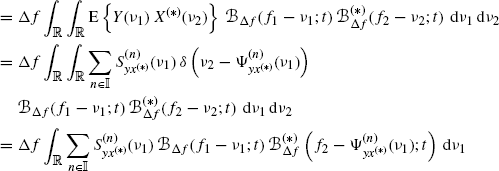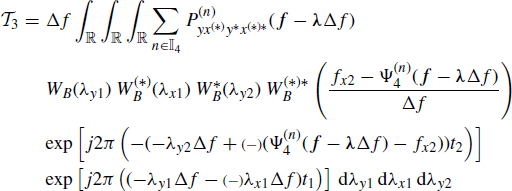5.2 Proofs for Section 4.4 “The Bifrequency Cross-Periodogram”
In this section, proofs of lemmas and theorems presented in Section 4.4 on bias and covariance of the bifrequency cross-periodogram are reported.
The following Lemma 5.2.1 allows, in the proofs of the subsequent lemmas and theorems, the free interchange of the order of limit and sum operations.
Lemma 5.2.1 (Napolitano 2003, Lemma A.1).
![]()
![]()
Proof: The uniform convergence of the function series ![]() is an immediate consequence of (4.97) and the Weierstrass criterium (Smirnov 1964). Moreover, since the functions
is an immediate consequence of (4.97) and the Weierstrass criterium (Smirnov 1964). Moreover, since the functions ![]() are uniformly bounded, accounting for (4.97), it results in
are uniformly bounded, accounting for (4.97), it results in ![]() and hence, for the Weierstrass criterium the function series
and hence, for the Weierstrass criterium the function series ![]() turns out to be uniformly convergent. Part b) of the Lemma can be proved analogously.
turns out to be uniformly convergent. Part b) of the Lemma can be proved analogously. ![]()
5.2.1 Proof of Lemma 4.4.6 Expected Value of the Bifrequency Cross-Periodogram
By substituting into (4.93) the STFTs ![]() and
and ![]() expressed according to (4.94b), and taking the expected value, one has
expressed according to (4.94b), and taking the expected value, one has

where, in the third equality, (4.95) with z1 = y and z2 = x(*) is used.
In the derivation of (5.6), the order of integral and expectation operators can be interchanged due to the Fubini and Tonelli theorem (Champeney 1990, Chapter 3). In fact, defined
(5.7) ![]()
and accounting for Assumptions 4.4.3a and 4.4.5, for the integrand function in the right-hand side of (5.6) we have
The interchange of sum and integral operations to obtain (4.106) from (5.6) is justified even if the set ![]() is not finite by using the dominated convergence theorem (Champeney 1990, Chapter 4). Specifically, by denoting with
is not finite by using the dominated convergence theorem (Champeney 1990, Chapter 4). Specifically, by denoting with ![]() an increasing sequence of finite subsets of
an increasing sequence of finite subsets of ![]() , i.e., such that
, i.e., such that ![]() for h < k and
for h < k and ![]() , we have
, we have
In fact, it results that
(5.10) ![]()
with the right-hand side bounded by the right-hand side of (5.8). That is, the integrand function in the second term of equality (5.9) is bounded by a summable function of ν1 not depending on k. ![]()
5.2.2 Proof of Lemma 4.4.7 Covariance of the Bifrequency Cross-Periodogram
For zero mean stochastic processes x(t) and y(t), also the STFTs ![]() and
and ![]() are zero mean. By specializing to N = 4 and zero-mean processes the expression of Nth-order cumulant in terms of Nth-and lower-order moments (4.39), the result is that
are zero mean. By specializing to N = 4 and zero-mean processes the expression of Nth-order cumulant in terms of Nth-and lower-order moments (4.39), the result is that
Thus, accounting for the STFT expression (4.94b), from (5.11) it follows that
Finally, by substituting (4.95) and (4.96) into (5.12), and using the sampling property of the Dirac delta, (4.108) follows.
The interchange of expectation, sum, and integral operations can be justified as in the proof of Lemma 4.4.6.
Lemma 5.2.2 (Napolitano 2003, Lemma A.2). Let Ψ(n)(f1) be a function satisfying Assumption 4.4.4 (support-curve regularity (I)). For any function V(ν) continuous a.e. and infinitesimal at ±∞, one has
for any λ1 such that ![]() is a continuity point of V.
is a continuity point of V.
Proof. If f2 ≠ Ψ(n)(f1), then f2 ≠ Ψ(n)(f1) definitively in a neighborhood of f1 since Ψ(n) is derivable and, hence, continuous. Thus, one has
(5.14) ![]()
from which it follows that
(5.15) ![]()
since V(ν) is continuous a.e. and infinitesimal at ±∞. Furthermore, if f2 = Ψ(n)(f1) then, from the assumption of derivability of Ψ(n)(f1), one has
(5.16) ![]()
Thus, (5.13) follows from the a.e. continuity of V. ![]()
Lemma 5.2.3 (Napolitano 2003, Lemma A.3). Let ![]() and
and ![]() be second-order harmonizable jointly SC stochastic processes with bifrequency cross-spectrum (4.15), and define the function
be second-order harmonizable jointly SC stochastic processes with bifrequency cross-spectrum (4.15), and define the function
Under Assumptions 4.4.3a (series regularity), 4.4.4 (support-curve regularity (I)), and 4.4.5 (data-tapering window regularity), one obtains
with E(n)(f1) defined in (4.113).
Proof. By making into (5.17) the variable change λ1 = (f1 − ν1)/Δf and accounting for (4.103) and (4.107) one has
Denoted by GΔf(λ1) the integrand function in (5.19) and accounting for (4.97) and Assumption 4.4.5, the result is that
(5.20) ![]()
with the right-hand side independent of Δf. Thus, the dominated convergence theorem (Champeney 1990) can be applied:
where, in obtaining (5.21), the limit (as Δf → 0) and the sum (over n) operations can be interchanged since WB is bounded (Assumption 4.4.5) and hence, by Lemma 5.2.1a, the integrand function series in (5.19) is uniformly convergent. Moreover, the sum and the integral operations can be interchanged due to the same arguments used in the proof of Lemma 4.4.6. Furthermore, since ![]() and is regular at ±∞, then is infinitesimal at ±∞. Thus, by substituting (5.13) (Lemma 5.2.2) with V = WB into (5.21) for all
and is regular at ±∞, then is infinitesimal at ±∞. Thus, by substituting (5.13) (Lemma 5.2.2) with V = WB into (5.21) for all ![]() except, possibly, the λ1s belonging to a set with zero Lebesgue maesure, (5.18) immediately follows.
except, possibly, the λ1s belonging to a set with zero Lebesgue maesure, (5.18) immediately follows. ![]()
Observe that, strictly speaking, to prove Lemmas 4.4.6, 5.2.1, and 5.2.3, Assumptions 4.4.3a and 4.4.4 need to hold only for z1 = y and z2 = x(*).
5.2.3 Proof of Theorem 4.4.8 Asymptotic Expected Value of the Bifrequency Cross-Periodogram
It immediately follows from Lemma 5.2.3 for t1 = t2 = t.
5.2.4 Proof of Theorem 4.4.9 Asymptotic Covariance of the Bifrequency Cross-Periodogram
The asymptotic covariance expression (4.115) is obtained from (4.108) as Δf → 0. In fact, the convergence, as Δf → 0, of the terms ![]() and
and ![]() (see (4.109) and (4.110)) to
(see (4.109) and (4.110)) to ![]() and
and ![]() (see (4.116) and (4.117)), respectively, can be easily proved by using Lemma 5.2.3. Moreover, the term
(see (4.116) and (4.117)), respectively, can be easily proved by using Lemma 5.2.3. Moreover, the term ![]() (see (4.111)) approaches zero as Δf → 0. In fact, by making into (4.111) the variable changes λy1 = (fy1 − νy1)/Δf, λx1 = (fx1 − νx1)/Δf, λy2 = (fy2 − νy2)/Δf and accounting for (4.103) and (4.107), one has
(see (4.111)) approaches zero as Δf → 0. In fact, by making into (4.111) the variable changes λy1 = (fy1 − νy1)/Δf, λx1 = (fx1 − νx1)/Δf, λy2 = (fy2 − νy2)/Δf and accounting for (4.103) and (4.107), one has
where f − λΔf ![]() [fy1 − λy1Δf, fx1 − λx1Δf, fy2 − λy2Δf].
[fy1 − λy1Δf, fx1 − λx1Δf, fy2 − λy2Δf].
Denoted by HΔf(λy1, λx1, λy2) the integrand function in (5.22) and accounting for (4.98) and Assumption 4.4.5 the result is that
(5.23) 
with the right-hand side independent of Δf. Thus,
(5.24) ![]()









